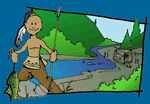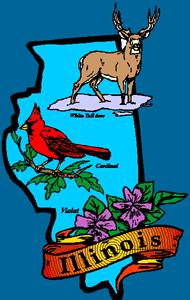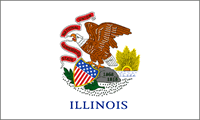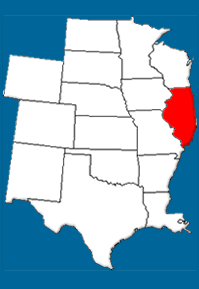


Geography and Landforms:
Broad, level lands known as the Central Plains, gave Illinois its nickname - the "Prairie State." These Central Plains cover nearly 90% of the state. This gently rolling land was created during the Ice Age when glaciers leveled the area and deposited material that would later become soil. More than 275 rivers from this region flow into the Mississippi-Ohio river system.
|
 History:
French explorers and missionaries were among the first Europeans to come to Illinois. Jacques Marquette and Louis Jolliet entered the region in 1673 from the French Canadian colonies to the north. They were sent by the governor of their colony to find and trace the Mississippi River. The two men traveled south along the western boundary of Illinois, then northward up the Illinois River. Two years later, Marquette returned to establish a mission at the Kaskaskia Indian village near present-day Utica.
|
 Economy:
Illinois is an important agricultural state. Rich farmland, adequate rainfall, and a long growing season contribute to its success as a leading producer of corn and soybeans. Other agricultural products include cattle, hogs, wheat, oats, sorghum, and hay.
|
 First Inhabitants:
The earliest inhabitants of Illinois were the prehistoric Mound Builders. These groups of Native Americans left behind more than 10,000 temple and burial mounds throughout the state. Monk's Mound, near present-day Cahokia, is the largest prehistoric earthen structure in the United States.
|
Books Related To IllinoisAcross Five Aprils - Irene Hunt America is Her Name - Luis Rodriguez Children of the Fire - Harriette Gillem Robinet Deliver Us from Normal - Kate Klise The Education of Robert Nifkin - Daniel Pinkwater Extra Credit - Andrew Clements Fair Weather - Richard Peck The House on Mango Street - Sandra Cisneros Journey of the Sparrows - Fran Leeper Buss L is for Lincoln: An Illinois Alphabet - Kathy-jo Wargin The Secret of the Painted House - Marion Dane Bauer A Spy on the Home Front - Alison Hart |
Famous Citizens:
|
| Capital: | Springfield |
| Entered Union: | December 3, 1818 |
| Population: | 12,880,580 |
| Area | 57,914 |
| Bird | Cardinal |
| Flower | Purple Violet |
| Nickname: | Prairie State |
| Governor | Bruce Rauner |
Places to Visit in Illinois: (Click the links to learn more.)
|



